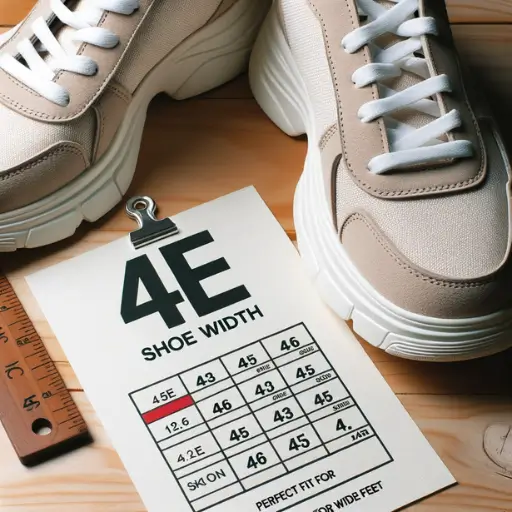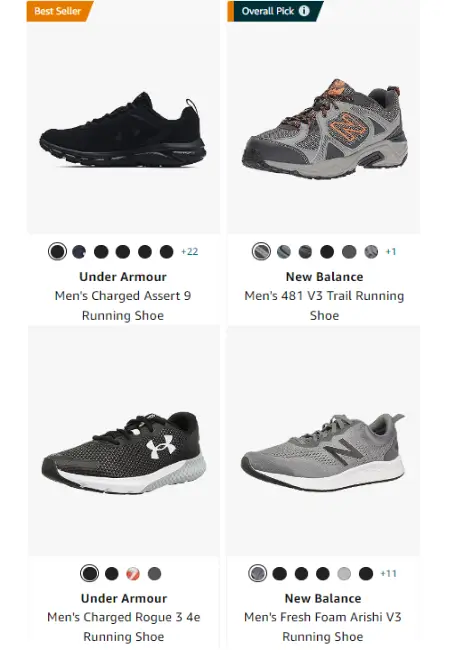What Does 4E Mean in Shoes? Guide to Shoe Size
Last Updated: January 01, 2025 | Author: James Leigh

When it comes to finding the perfect pair of shoes, size indeed matters. However, the length of the shoe isn't the only factor to consider; the width is equally crucial to ensure a comfortable fit. The term "4E" in shoe sizes is a representation of width, particularly for those with wider feet. In this comprehensive guide What Does 4E Mean in Shoes, we will delve into the meaning of 4E in shoes, how it compares to other width sizes, and why getting the width right is essential for your foot health.
Key Takeaways:
- Understanding Shoe Width: The lettering system, ranging from 2A to 6E, represents the width of the shoe.
- Importance of Correct Shoe Width: Wearing the correct shoe width helps in avoiding foot problems and enhancing comfort and performance.
- Measuring Your Shoe Width: A simple process that can be done at home or with the help of a professional.
- Comparing 4E with Other Width Sizes: 4E represents an extra-wide shoe width, ideal for individuals with wide feet.
Understanding the "4E" in Shoe Sizing
| Feature | Description | Comparison | Further Reading |
|---|---|---|---|
| Width Indicator | "4E" signifies extra wide width in shoes. | Standard: M, Wide: W, Extra Wide: 4E | What does 'C' mean in shoe size? |
| Applicability | Suited for individuals with wider feet. | Narrow Feet: 2A, Regular Feet: M | Understanding 'D' in shoe sizes |
| Measuring Width | Measurement across the broadest part of the foot. | Use a width measuring tool. | Explore 'EP' shoe terminology |
| Common Brands Offering | New Balance, ASICS, Brooks. | Many brands offer a variety of widths. | Delve into 'GS' in shoe sizes |
| Importance | Prevents blisters, calluses and other foot ailments. | Right width ensures foot health. | Discover 'PS' in shoe sizing |
| Shopping Tip | Look for "4E" or "Extra Wide" on shoe boxes. | Always try before you buy. | Uncover 'QS' in shoe terms |
| Alternative Sizing | 2E for wide, 6E for wider options. | 4E sits in the middle. | Decoding 'REPS' in shoes |
| Abbreviation Origin | Shoe manufacturers use letters for width indication. | E letters signify varying widths. | Learn about 'SE' in shoe sizes |
| Foot Health | Proper width alleviates pressure on foot ligaments. | Ensures comfortable stride. | Dive into 'SP' shoe terminology |
| Popular Styles | Sneakers, Running Shoes, Casual Footwear. | Available in various shoe styles. | Understanding 'TD' in shoes |
Understanding Shoe Width: The Basics
Decoding the Lettering System
Shoe width is typically denoted by letters, ranging from 2A (narrow) to 6E (extra wide), with 4E representing a wide width. The more the letter "E" repeats, the wider the shoe. The width letters are a crucial factor to consider, especially for individuals with wider or narrower feet, as it significantly impact the comfort and fit of the shoe.
Difference Between Standard and Wide Width
A standard width shoe, often denoted by the letter "D" for men and "B" for women, may not provide the required room for individuals with wider feet. On the other hand, a 4E width shoe offers more space across the width of the shoe, particularly around the forefoot and toe box areas, allowing for a more comfortable fit.
Importance of Correct Shoe Width
Avoiding Foot Problems
Wearing shoes of incorrect width can lead to a myriad of foot problems. Too narrow shoes can cause blisters, calluses, and other foot ailments like bunions and hammertoes. Meanwhile, overly wide shoe sizes can result in excessive friction, leading to similar issues. Getting the width right is crucial for avoiding such complications.
Enhancing Comfort and Performance
The correct shoe width ensures that your feet have ample space to move and breathe, enhancing overall comfort. Moreover, for athletes, the right shoe width can significantly impact performance on the court or the field.
Measuring Your Shoe Width
Tools and Techniques
Measuring your shoe width is a straightforward process that requires a measuring tape, a sheet of paper, and a pen. Trace the outline of your foot on the paper, then measure the widest part of the outline to determine your foot's width. Comparing this measurement to a shoe width chart will help you find your correct width size.
Consulting a Professional
If you're unsure about measuring your shoe width accurately, consulting a professional, like a certified health professional or a seasoned runner, could provide valuable insights. They can guide you through the process and even recommend brands known for their wide-width shoes.
Understanding the Terminology in Shoe Width
| Term | Meaning | Ideal For |
|---|---|---|
| 2E (Wide Width) | A size wider than the standard width, providing a bit more space for a wider foot. | Individuals with slightly wider feet |
| 4E (Extra Wide) | Significantly wider than the standard, offering ample space across the width of the shoe. | Individuals with wide feet |
| 6E (Ultra Wide) | The widest size available in the regular market, providing maximum width. | Individuals with very wide feet |
| AA, A | Narrow widths, where AA is narrower than A. | Individuals with narrow feet |
| B (Standard) | The standard width for women’s shoes. | Most women with regular foot width |
| D (Standard) | The standard width for men’s shoes. | Most men with regular foot width |
| M (Medium) | Another term for standard width in both men’s and women’s shoes. | Individuals with regular foot width |
4E Width Vs. Other Width Sizes
Understanding the difference in width between various shoe sizes is crucial for finding the perfect fit, especially if you have specific foot conditions or just prefer a more comfortable or snug fit.
Comparing 4E with Other Width Sizes
| Width Size | Description | Ideal For |
|---|---|---|
| 2A | Narrow width | Individuals with narrower feet |
| B or D | Standard width | Individuals with standard feet |
| 2E or W | Wide width | Slightly wider feet |
| 4E | Extra wide width | Individuals with wide feet |
| 6E | Ultra wide width | Individuals with very wide feet |
2E Vs. 4E: A Closer Look
- Overall Width: 4E is wider than 2E.
- Foot Width: 4E provides more room across the width, especially around the forefoot and heel areas.
- Ideal For: 4E is perfect for wider feet, while 2E suits those with a slightly wider foot than normal.
4E Vs. 6E: The Width Difference
- Overall Width: 6E is the widest standard width available, wider than 4E.
- Inside the Shoes: 6E provides the most room inside, reducing the chance of blisters and other foot issues.
- Ideal For: Individuals with very wide feet or medical conditions that require extra room in footwear.
Shoe Width Chart: A Handy Reference
| Length Size | Standard Width (D or B) | Wide (2E) | Extra Wide (4E) | Ultra Wide (6E) |
|---|---|---|---|---|
| 8 | 3.3" | 3.5" | 3.7" | 3.9" |
| 9 | 3.3" | 3.6" | 3.8" | 4.0" |
| 10 | 3.5" | 3.7" | 3.9" | 4.1" |
| 11 | 3.6" | 3.8" | 4.0" | 4.2" |
This chart gives a rough idea of how the width increases with each width size up. The measurements across the width of the shoe help in understanding how much extra space each width size provides.
Perfect Fit: Key to Foot Health
Finding the right width shoe is not just about comfort; it's about promoting better foot health. A shoe that fits well in terms of length and width ensures lesser chances of foot problems, a better gait, and a more comfortable day, whether you're on a trip, at work, or simply going about your day. Your feet tend to swell during the day, and a shoe with a better fit in width can accommodate that natural expansion without causing discomfort or health issues like soreness, blisters, or calluses.

Frequently Asked Questions:
1. What does 4E mean in shoe sizes?
4E refers to a specific shoe width size that is categorized as extra wide. In the spectrum of shoe widths, it falls somewhere between 2E (wide) and 6E (ultra-wide), providing a comfortable fit for individuals with wider feet.
2. How do I know if I need a 4E width shoe?
Measuring shoe width is crucial to determine if a 4E width shoe is ideal for you. Generally, if standard or 2E width shoes feel too tight, especially around the forefoot or heel of the shoes, you may find a more comfortable fit with 4E width shoes.
3. Can I switch between different shoe widths like 2E, 4E, or even 4A?
It's possible, but it all boils down to your foot's contour and comfort. It's always advisable to stick to the width that aligns with your foot width to prevent issues like soreness, blisters, or other foot ailments. Shoe manufacturers design different shoe widths to cater to the diverse foot shapes among individuals.
4. What's the difference between 4E and other width sizes like 2E or 6E?
4E is wider than 2E but narrower than 6E. The main difference lies in the overall width of the shoe, which impacts the space inside the shoes, especially around the arch, tip, and heel. Ensuring a proper fit in these areas can significantly enhance comfort and prevent foot problems.
5. Why might someone consider buying 4E width sneakers over normal width sneakers?
People with wider feet, certain foot conditions, or those who experience discomfort and tightness with normal width sneakers might find 4E width sneakers a better option. They provide extra room and comfort, accommodating a broader foot shape and reducing the chances of friction and pressure that can lead to blisters, soreness, or other foot issues.




